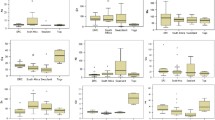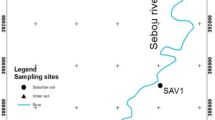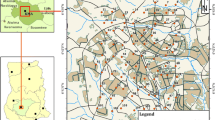Abstract.
Chemical data from soil and weathered waste material samples collected from five uranium mines north of the Grand Canyon (three reclaimed, one mined but not reclaimed, and one never mined) were used in a screening-level risk analysis for the Arizona chisel-toothed kangaroo rat (Dipodomys microps leucotis); risks from radiation exposure were not evaluated. Dietary toxicity reference values were used to estimate soil-screening thresholds presenting risk to kangaroo rats. Sensitivity analyses indicated that body weight critically affected outcomes of exposed-dose calculations; juvenile kangaroo rats were more sensitive to the inorganic constituent toxicities than adult kangaroo rats. Species-specific soil-screening thresholds were derived for arsenic (137 mg/kg), cadmium (16 mg/kg), copper (1,461 mg/kg), lead (1,143 mg/kg), nickel (771 mg/kg), thallium (1.3 mg/kg), uranium (1,513 mg/kg), and zinc (731 mg/kg) using toxicity reference values that incorporate expected chronic field exposures. Inorganic contaminants in soils within and near the mine areas generally posed minimal risk to kangaroo rats. Most exceedances of soil thresholds were for arsenic and thallium and were associated with weathered mine wastes.


Similar content being viewed by others
References
Aburto EM, Cribb AE, Fuentealba IC, Ikede BO, Kibenge FSB, Markham F (2001) Morphological and biochemical assessment of the liver response to excess dietary copper in Fischer 344 rats. Can J Vet Res 65:97–103
Allard P, Fairbrother A, Hope BK, Hull RN, Johnson MS, Kapustka L et al (2009) Recommendations for the development and application of wildlife toxicity reference values. Integr Environ Assess Monit 6:28–37
Alpine A (2010) Hydrological, geological, and biological sites characterization of breccia pipe uranium deposits in Northern Arizona. United States Geological Survey, Scientific Investigations Report 2010–5025
Ambrose AM, Larson PS, Borzelleca JF, Hennigar GR (1976) Long-term toxicologic assessment of nickel in rats and dogs. J Food Sci Technol 13:181–187
Azar A, Trochimowicz HJ, Maxfield ME (1973) Review of lead studies in animals carried out at Haskell Laboratory—Two-year feeding study and response to hemorrhage study. In: Barth D, Berlin A, Engel R, Recht P, Smeets J (eds) Environmental health aspects of lead: Proceedings International Symposium; October 1972; Amsterdam. Commission of the European Communities, Luxemberg. pp 199–208
Barron MG, Wharton SR (2005) Survey of methodologies for developing media screening values for ecological risk assessment. Integr Environ Assess Monit 1:320–332
Beaugelin-Seiller K, Garnier-Laplace J, Gilbin R, Adam C (2009) A unified ecological risk assessment on freshwaters for chemical and radiological ecotoxicity: the uranium case. Radioprotection 44:913–918
Bechtel Jacobs (1998) Empirical models for the uptake of inorganic chemicals from soil by plants. Prepared for the United States Department of Energy, Oak Ridge, BJC/OR-133
Beyer WN, Connor EE, Gerould S (1994) Estimates of soil ingestion by wildlife. J Wildl Manag 58:375–382
Bureau of Land Management (2011) Northern Arizona proposed withdrawal final environmental impact statement. BLM/AZ/PL-11/002. Volumes 1 and 2
Byron WR, Bierbower GW, Brouwer JB, Hansen WH (1967) Pathologic changes in rats and dogs from two-year feeding of sodium arsenite or sodium arsenate. Toxicol Appl Pharm 10:132–147
Chapman PM, Fairbrother A, Brown D (1998) A critical evaluation of safety (uncertainty) factors for ecological risk assessment. Environ Toxicol Chem 17:99–108
Department of Interior (2012) Record of Decision for the Northern Arizona Withdrawal. http://www.blm.gov/pgdata/etc/medialib/blm/az/pdfs/withdraw/feis.Par.88586.File.dat/NorthernArizona-ROD-v20-1%2011%202012_wsignederrata.pdf. Accessed 3 Nov 2012
Downs WI, Scott JK, Steadman LT, Maynard EA (1960) Acute and sub-acute toxicity studies of thallium compounds. Am Ind Hyg Assoc J 21:399–406
Duke LD, Taggart M (2000) Uncertainty factors in screening ecological risk assessments. Environ Toxicol Chem 19:1668–1680
Escribano A, Revilla M, Hernandez ER, Seco C, Gonzalez-Riola J, Villa LF et al (1997) Effect of lead on bone development and bone mass: A morphometric, densitometric, and histomorphometric study in growing rats. Calcif Tissue Int 60:200–203
Franke KW, Moxon AL (1937) The toxicity of orally ingested arsenic, selenium, tellurium, vanadium and molybdenum. J Pharmacol Exp Ther 61:89
Fuentealba IC, Mullins JE, Aburto EM, Lau JC, Cherian GM (2000) Effect of age and sex on liver damage due to excess dietary copper in Fischer 344 rats. Clin Toxicol 38:709–717
Genoways HH, Brown JH (1993) Biology of the heteromyidae. Special publication No. 10, The American society of mammalogists
Gerstenberger SL, Cross CL, Divine DD, Gulmatico ML, Rothweiler AM (2006) Assessment of mercury concentrations in small mammals collected near Las Vegas, Nevada, USA. Environ Toxicol 21:583–589
Gonzalez-Riola J, Hernandez ER, Escribano A, Revilla M, Seco C, Villa LF et al (1997) Effect of lead on bone and cartilage in sexually mature rats: a morphometric and histomorphometry study. Environ Res 74:91–93
Groten JP, Sinkeldam EJ, Luten JB, van Bladeren PJ (1990) Comparison of the toxicity of inorganic and liver-incorporated cadmium: a 4-wk feeding study in rats. Food Chem Toxicicol 28:435–441
Hayssen V (1991) Dipodomys microps. Mammalian Species 389:1–9
Haywood S (1980) The effect of excess dietary copper on the liver and kidney of the male rat. J Comp Path 90:217–232
Haywood S, Trafford J, Loughran M (1985) Copper toxicosis and tolerance in the rat: IV. Renal tubular excretion of copper. Br J Exp Pathol 66:699–707
Hebert CD (1993) NTP Technical report on toxicity studies of cupric sulfate administered in drinking water and feed to F344/N rats and B6C3F1 mice. National toxicology program. Toxicity report series number 29. NIH publication 93-3352
Hebert CD, Elwell MR, Travlos GS, Fitz CJ, Bucher JR (1993) Subchronic toxicity of cupric sulfate administered in drinking water and feed to rats and mice. Fundm Appl Toxicol 21:461–475
Hinck JE, Linder G, Finger S, Little E, Tillitt D, Kuhne W (2010) Biological pathways of exposure and ecotoxicity values for uranium and associated radionuclides. In: Alpine A (ed) Hydrological, geological, and biological sites characterization of breccia pipe uranium deposits in Northern Arizona. United States Geological Survey, Scientific Investigations Report 2010–5025, pp 283–353
Jamall IS, Nalik M, Sprowls JJ, Trombetta LD (1989) A comparison of the effects of dietary cadmium on heart and kidney antioxidant enzymes: evidence for the greater vulnerability of the heat to cadmium toxicity. J Appl Toxicol 9:339–345
L’Abbe MR, Fischer WF (1984) The effects of dietary zinc on the activity of copper-requiring metalloenzymes in the rat. J Nutr 114:823–828
Linder G, Joermann G (2001) Assessing hazard and risk of chemical exposures to wild mammals: food-chain analysis and its role in ecological risk assessment. In: Shore RF, Rattner BA (eds) Ecotoxicology of wild mammals. Wiley, Chichester, pp 635–670
Linder G, Henderson G, Ingham I (2003) Wildlife and remediation of contaminated soils: Extending the analysis of ecological risks to habitat restoration. In: Hoffman DJ, Rattner BA, Burton GA Jr, Cairns J Jr (eds) Handbook of ecotoxicology, 2nd edn. Lewis, Boca Raton, pp 167–189
Llewellyn GC, Floyd EA, Hoke GD, Weekley LB, Kimbrough TD (1985) Influence of dietary aflatoxin, zinc, and copper on bone size, organ weight, and body weight in hamsters and rats. Bull Environ Contam Toxicol 35:149–156
Loeser E, Lorke D (1977) Semichronic oral toxicity of cadmium. 1 studies on rats. Toxicology 7:215–224
Machemer L, Lorke D (1981) Embryonic effect of cadmium on rats upon oral administration. Toxicol Appl Pharmacol 58:438–443
Maita K, Hirano M, Mitsumori K, Takahashi K, Shirasu Y (1981) Subacute toxicity studies with zinc sulfate in mice and rats. J Pesticide Sci 6:327–336
Mayfield DB, Fairbrother A (2012) Efforts to standard wildlife toxicity reference values remain unrealized. Integr Environ Assess Monit 9:114–123
Maynard EA, Hodge HC (1949) Studies of the toxicity of various uranium compounds when fed to experimental animals. In: Voegtlin C, Hodge HC (eds) The pharmacology and toxicology of uranium compounds. Nations Nuclear Energy Service. Division VI, vol 1. McGraw Hill, New York, pp 309–376
Morris SA, Thompson HM (2011) Dehusking of seed by small mammals: default values for use in risk assessment. Integr Environ Assess Manag 7:147–148
Morton SR, Hinds DS, MacMillen RE (1980) Cheek pouch capacity in heteromyid rodents. Oecologia 46:143–146
Nagaraja TN, Desiraju T (1994) Effects on operant learning and brain acetylcholine esterase activity in rats following chronic inorganic arsenic intake. Hum Exp Toxicol 13(5):353–356
Nagy KA, Girard IA, Brown TK (1999) Energetics of free-ranging mammals, reptiles, and birds. Annu Rev Nutr 19:247–277
Nakamura K, Nishiyama S, Takata T, Suzuki E, Sigiura Y, Kobayashi T et al (1983) Effects of zinc on cadmium-induced alterations in hepatic function and blood glucose of rats. Environ Res 30:175–181
Niethammer KR, Atkinson RD, Baskett TS, Samson FB (1985) Metals in riparian wildlife of the lead mining district of southeastern Missouri. Arch Environ Contam Toxicol 14:213–223
Otton, JK, Van Gosen BS (2010) Uranium resource availability in breccia pipes in northern Arizona. In: Alpine A (ed) Hydrological, geological, and biological sites characterization of breccia pipe uranium deposits in Northern Arizona. United States Geological Survey, Scientific Investigations Report 2010–5025, pp 19–42
Otton JK, Gallegos TJ, Van Gosen BS, Johnson RH, Zielinski RA, Hall SM, et al. (2010) Effects of 1980s uranium mining in the Kanab Creek area of northern Arizona. In: Alpine A (ed) Hydrological, geological, and biological sites characterization of breccia pipe uranium deposits in Northern Arizona. United States Geological Survey, Scientific Investigations Report 2010-5025, pp 43–134
Reichman OJ, Smith SC (1990) Burrows and burrowing behavior by mammals. In Genoways HH (ed) Current mammalogy. Chapter 5. Plenum, New York, pp 197–244
Reynolds HG (1958) The ecology of the Merriam kangaroo rat (Dipodomys merriami Mearns) on the grazing lands of southern Arizona. Ecol Mono 28:111–127
Sample BE, Arenal CA (1999) Allometric models for interspecies extrapolation of wildlife toxicity data. Bull Environ Contam Toxicol 62:653–663
Schlicker SA, Cox DH (1968) Maternal dietary zinc, and development and zinc, iron, and copper content of the rat fetus. J Nutrition 95:287–294
Schmidt-Nielsen K (1964) Desert animals: physiological problems of heat and water. Oxford University Press, London
Schmidt-Nielsen K, Schmidt-Nielsen B (1952) Water metabolism of desert mammals. Physiol Rev 32:135–166
Sutton WR, Nelson VE (1937) Studies on zinc. Proc Soc Exp Biol Med 36:211–213
Suzuki S, Arnold LL, Ohnishi T, Cohen SM (2008) Effects of inorganic arsenic on the rat and mouse urinary bladder. Toxicol Sci 106:350–363
Tannenbaum LV (2005) A critical assessment of the ecological risk assessment process: a review of misapplied concepts. Integr Environ Assess Monit 1:66–72
Tracy RL, Walsberg GE (2002) Kangaroo rats revisited: re-evaluating a classic case of desert survival. Oecologia 133:449–457
United States Environmental Protection Agency (1988) Recommendations for and documentation of biological values for use in risk assessment. Environmental Criteria and Assessment Office, Cincinnati, OH. EPA/600/6-87/008
United States Environmental Protection Agency (2005a) Guidance for developing ecological soil screening levels (Eco-SSLs). OSWER 92857-55. http://www.epa.gov/ecotox/ecossl/SOPs.htm. Accessed 3 Nov 2012
United States Environmental Protection Agency (2005b) Ecological soil screening levels for arsenic. Office of Solid Waste and Emergency Response, Washington, DC
United States Environmental Protection Agency (2005c) Ecological soil screening levels for cadmium. Office of Solid Waste and Emergency Response, Washington, DC
United States Environmental Protection Agency (2005d) Ecological soil screening levels for lead. Office of Solid Waste and Emergency Response, Washington, DC
United States Environmental Protection Agency (2007a) Ecological soil screening levels for copper. Office of Solid Waste and Emergency Response, Washington, DC
United States Environmental Protection Agency (2007b) Ecological soil screening levels for nickel. Office of Solid Waste and Emergency Response, Washington, DC
United States Environmental Protection Agency (2007c) Ecological soil screening levels for zinc. Office of Solid Waste and Emergency Response, Washington, DC
United States Environmental Protection Agency (2007d) Ecological revitalization and attractive nuisance issues. Office of Superfund Remediation and Technology Innovation. EPA 542-F-06-003
Vandenhove H, Olyslaegers G, Sanzharova N, Shubina O, Reed E, Shang Z et al (2009) Proposal for new best estimates of the soil-to-plant transfer factor of U, Th, Ra, Pb and Po. J Environ Radioact 100:721–732
Vanek A, Komarek M, Chrastny V, Becka D, Mihaljevic M, Sebek O et al (2010) Thallium uptake by white mustard (Sinapis alba L.) grown on moderately contaminated soils-Agro-environmental implications. J Hazard Mater 182:303–308
Waalkes MP, Rehm S (1992) Carcinogenicity of oral cadmium in male wister (WF/NCr) rat: effect of chronic dietary zinc deficiency. Fundam Appl Toxicol 19:512–520
Whanger PD (1973) Effects of dietary nickel on enzyme activities and mineral contents in rats. Toxicol Appl Pharm 25:323–331
White CR (2003) The influence of foraging mode and arid adaptation on the basal metabolic rates of burrowing mammals. Physiol Biochem Zool 76:122–134
Wills JH, Groblewski GE, Coulston F (1981) Chronic and multigeneration toxicities of small concentrations of cadmium in the diets of rat. Ecotoxol Environ Safe 5:452–464
Acknowledgments
We thank Kim Chojnacki for creating the map and W. Nelson Beyer, Brad Sample, Chris Schmitt, and two anonymous reviewers for reviewing earlier drafts of the manuscript. Any use of trade, product, or firm names is for descriptive purposes only and does not imply endorsement by the United States Government.
Author information
Authors and Affiliations
Corresponding author
Electronic supplementary material
Below is the link to the electronic supplementary material.
Rights and permissions
About this article
Cite this article
Hinck, J.E., Linder, G., Otton, J.K. et al. Derivation of Soil-Screening Thresholds to Protect the Chisel-Toothed Kangaroo Rat from Uranium Mine Waste in Northern Arizona. Arch Environ Contam Toxicol 65, 332–344 (2013). https://doi.org/10.1007/s00244-013-9893-5
Received:
Accepted:
Published:
Issue Date:
DOI: https://doi.org/10.1007/s00244-013-9893-5




